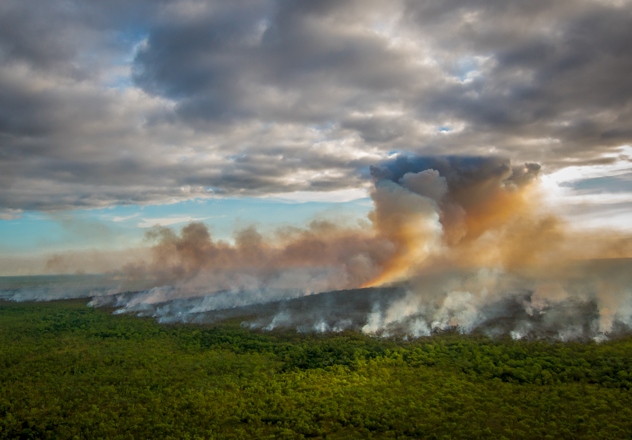Piccaninny Plains lies in the heart of Cape York Peninsula, a region of global significance for conservation. Covering almost 165,000 hectares, Piccaninny Plains is a property of stunning ecological diversity, protecting a mosaic of rainforests, woodlands, wetlands and grasslands and iconic wildlife like the Palm Cockatoo, Red Goshawk and Spotted Cuscus.

Piccaninny Plains is jointly owned by AWC and The Tony & Lisette Lewis Foundation - WildlifeLink. AWC is responsible for delivering land management and science programs on the property. The partnership represents an exciting new model for collaboration in the private conservation sector in Australia.


Cape York Peninsula has been connected to New Guinea for much of the last 250,000 years. The repeated exchange of flora and fauna has left behind a rich biological legacy. Piccaninny Plains protects an impressive representation of this evolutionary mix. Its woodlands are distinctly Australian, dominated by antipodean species such as eucalypts, acacias and kangaroos. In contrast, the rainforests that thread their way across the property have a strong New Guinean feel, supporting charismatic species like the Spotted Cuscus.
Situated in the centre of Cape York Peninsula, Piccaninny Plains extends from the foothills of the McIlwraith Range to the western plains of the Gulf of Carpentaria. Fifty-two kilometres of the Archer River and its towering gallery forest form the southern boundary. From here, a network of wetlands, woodlands, tall grasslands and deciduous vine forests extend 60 kilometres to the north, meeting the rainforests of the Wenlock River and the north eastern boundary.
Piccaninny Plains is subject to the ‘wet’ and ‘dry’ seasons typical across northern Australia. In summer, monsoonal rains swell the rivers and creeks into a continuous expanse of water that spreads over hundreds of square kilometres, effectively cutting off access. Once the monsoon withdraws, the land becomes progressively drier with even the larger rivers receding to a steady trickle between a string of pools in wide sandy beds. Away from the waterways, deeply cracking clay soils underlie much of the property. Shallow depressions in the clay called “gilgai” retain water, and provide important habitat for months after the wet season.
The sanctuary provides a critical corridor that helps link the east and west coasts of Cape York Peninsula. It contains stretches of two of Australia’s most important rivers (the Wenlock River boasts more fish species than any other in Australia) and supports the majority (in some cases the entirety) of several distinct ecosystem types. Among the magnificent gallery forests there is one rainforest type found nowhere else in the world, and the property contains the largest and most intact tropical grasslands in the high rainfall belt of northern Australia. These grasslands have been destroyed elsewhere by intensive grazing and cultivation.
The combination of Australian and New Guinean wildlife explains why Piccaninny Plains supports such a diversity of species. In Australia, many of these animals are found only on Cape York Peninsula – like the Yellow-billed Kingfisher, Eclectus Parrot, Trumpet Manucode and Magnificent Riflebird.
The open woodlands and grassland that cover the majority of the property are home to well over a hundred species of birds including seed-eating parrots, finches, quails and doves, insect-eating flycatchers, swallows, whistlers, wagtails, predatory raptors and owls, and many more. Reptiles abound in this habitat with many species of pythons, venomous snakes, skinks, geckos, dragon lizards and goannas. Mammals of these open woodlands include two (probably three) species of bandicoot, wallabies, possums, gliders, small carnivorous marsupials such as the Red-cheeked Dunnart, and native rodents such as the elusive Black-footed Tree Rat. The mammal fauna also feature some of the country’s rarest bats including the Papuan Sheath-tailed Bat and the Cape York Free-tailed Bat.
Piccaninny Plains contains a vast network of wetlands, providing a haven for resident and migratory waterbirds, fresh and saltwater crocodiles, aquatic snakes, over 20 species of frogs, freshwater crabs, 4 turtles and 30 species of fish. The Spotted Whistling Duck was a highlight of recent biological surveys.
Gallery and vine forests are home to some of the sanctuary’s more striking wildlife, including the Spotted Cuscus, Striped Possum, Palm Cockatoo, Magnificent Riflebird, Amethystine Python and White-Lipped Tree Frog. These forests also contain some distinctive tree species, such as the towering Bamaga Satinash and Native Crepe Myrtle.
AWC’s active land management at Piccaninny Plains, with a strong focus on fire management and feral animal control, is playing a critical role in providing a secure future for the wildlife of Cape York. The survival of a suite of mammals that have severely declined across northern Australia (such as the Black-footed Tree-rat), demonstrates the integrity of the habitats on the property.
The field program at Piccaninny Plains includes:
Red Goshawks have been confirmed at our Piccaninny Plains, Mornington-Marion Downs and Brooklyn sanctuaries.
The Northern Brown Bandicoot is common on the east coast of Australia north from the Hawkesbury River up to the...
The Eastern Bandy-bandy Snake (Vermicella annulata) is particularly striking as a result of their distinctive black and white banding pattern.
 © Sally Gray/AWC
© Sally Gray/AWC
The primary threats to wildlife on Cape York are wildfire and feral herbivores, largely through the destruction of important habitat. Both of these threats exacerbate predation on small mammals by feral cats, and are the subject of ongoing research by AWC’s science team to develop the most effective management strategy. AWC has implemented fire management across Piccaninny Plains to reduce the impact of hot late-season fires, and we are constantly removing pigs, cattle and horses from the property.
Help us protect this unique corner of Australia
Donate Now